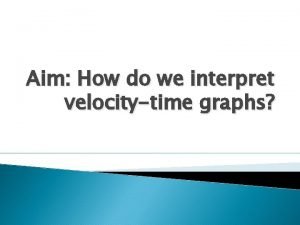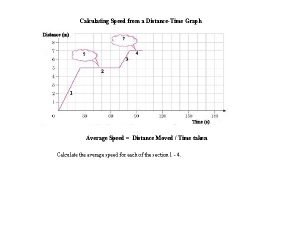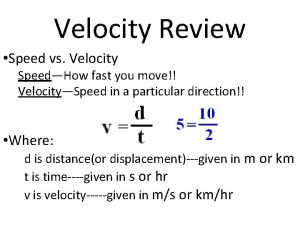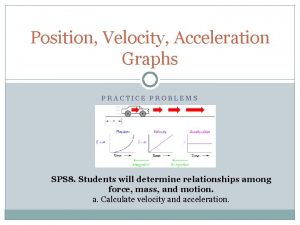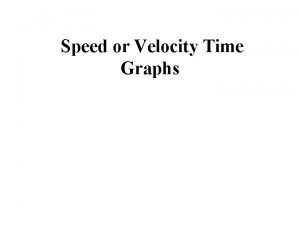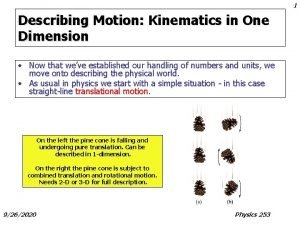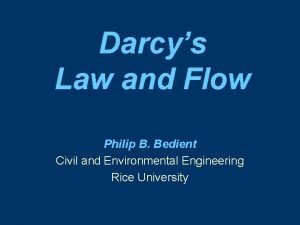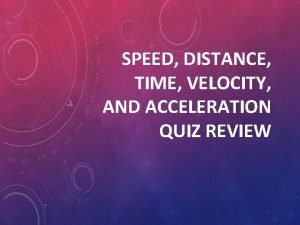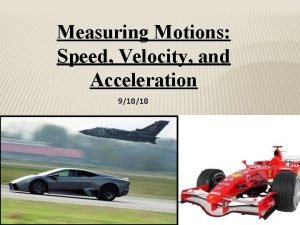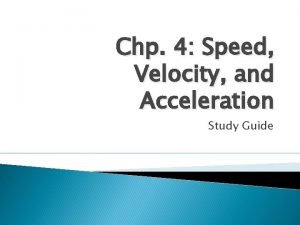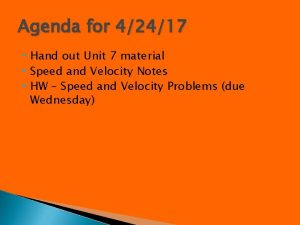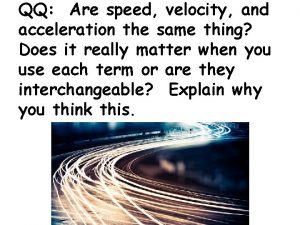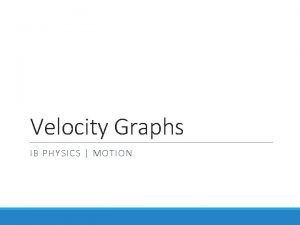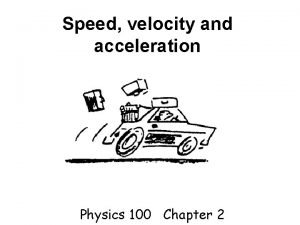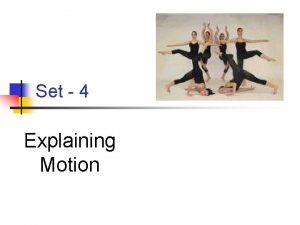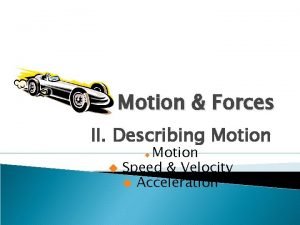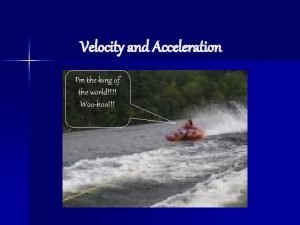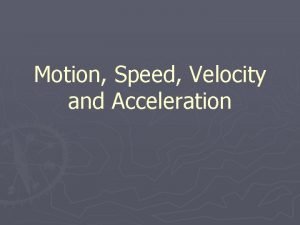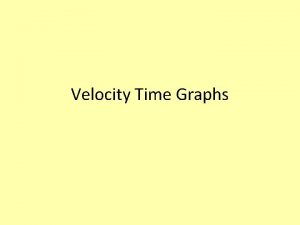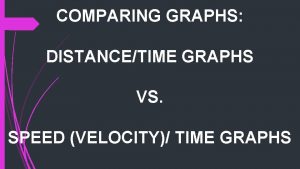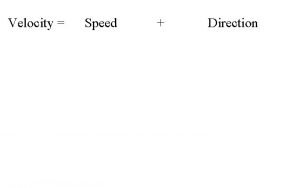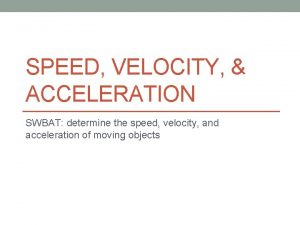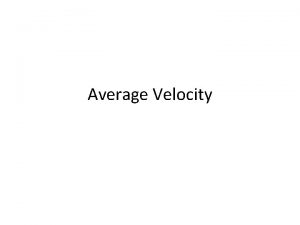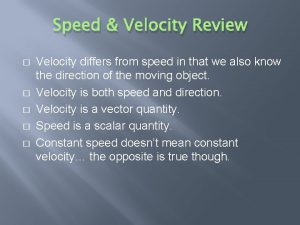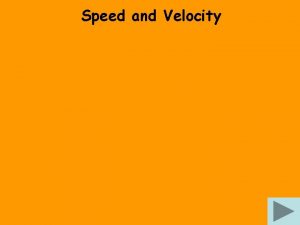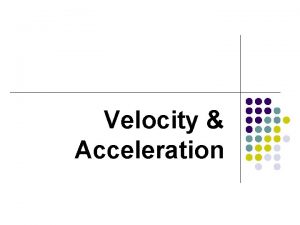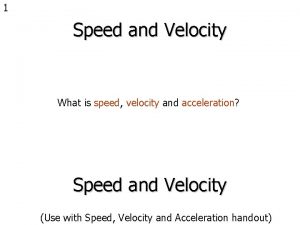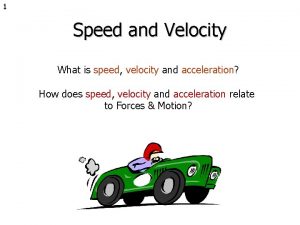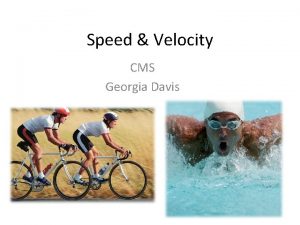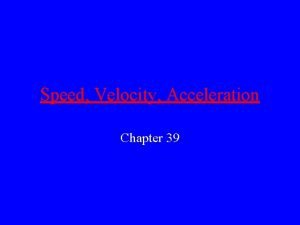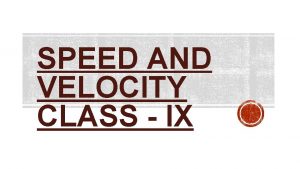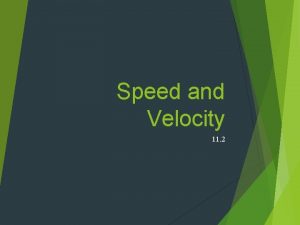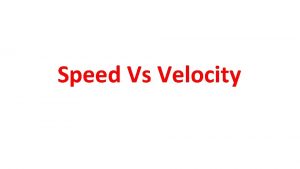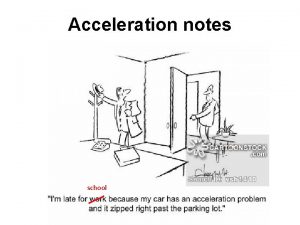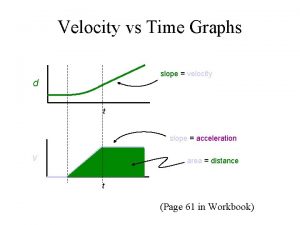Speed or Velocity Time Graphs Do In Notes











































- Slides: 43

Speed or Velocity Time Graphs

Do In Notes: Sketch a d – t graph for object moving at constant speed. Now sketch a speed time graph showing the same motion. d v t t

Constant Velocity/Speed

Sketch a distance – t graph for object starting from rest and speeding up with constant acceleration. Now sketch a speed time graph showing the same motion. v d t t

Constant / Uniform Acceleration. Slope = Constant Acceleration of straight line on v-t graph. Average Velocity is the midpoint between 2 speeds. vf + vi 2

1. What is the acceleration of this object? • • • Slope = accl. Dy/ Dx (50 – 10) m/s (5 – 1) s What is the sign of accl? What is the average speed between 1 – 3 seconds? What is the average speed between 3 – 5 seconds?

2. What is the acceleration between: 0 – 3 seconds, 5 -10 seconds? • Slope = 2 m/s 2. • 0.

3. What’s going on here?

Velocity Time Graphs Vector Nature sign of acceleration

Sign of velocity.


Finding Distance or Displacement on V-T graphs Speed Time = distance Velocity Time = displacement

Displacement = Area Under Curve at specific time. Drop a vertical to the X axis. 4. What is the displacement at 20 sec? A = bh = (20 s)(30 m/s)

5. What is the displacement at 5 s? Area = bh = (5 s) x (1 m/s) = 5 m.

6. What is the displacement at 4 seconds? A = ½ bh = ½ (4 s)(40 m/s) = 80 m.

7. What is the displacement at 10 s? • A 1 = 1/2 bh = 1/2(4 s)(8 m/s) = 16 m • A 2 = bh = (6 s) (8 m/s) = 48 m • A tot = 64 m.

Return to start point

8. How can you tell when object is back to starting point? • Positive displacement = negative displacement. • Tot displacement = 0.

9. At what time does the object return to the starting point? • At 5 seconds d = bh =(5 s)(1 m/s)= + 5 m. • From 5 – 10 seconds d = bh =(5 s)(-1 m/s)= - 5 m. • At t = 10 s.

Given the v – t graph below, sketch the acceleration – t graph for the same motion.

Acceleration – time Graphs • What is the physical behavior of the object? • Slowing down pos direction, constant vel neg accel.

• d-t: – slope = velocity – area ≠. • v-t: – slope = accl – area = displ • a-t: – slope ≠. – area = D vel – vf – vi.

Hwk. handout “Motion Graph Prac”.

Objects Falling Under Gravity

Freefall Gravity accelerates uniformly masses as they fall and rise. Earth’s acceleration rate is 9. 81 m/s 2 – very close to 10 m/s 2.

Falling objects accelerate at the same rate in absence of air resistance

But with air resistance

Fortunately there is a “terminal fall velocity. ” After a while, the diver falls with constant velocity due to air resistance. Unfortunately terminal fall velocity is too large to live through the drop.

Apparent Weightlessness Objects in Free-fall Feel Weightless

What is the graph of a ball dropped?


What do the d-t, v-t, and a – t, graphs of a ball thrown into the air look like if it is caught at the same height?

A ball is thrown upward from the ground level returns to same height. d = ball’s height above the ground velocity is + when the ball is moving upward Why is acceleration negative? Is there ever deceleration? a is -9. 81, the ball is accelerating at constant 9. 81 m/s 2.

Free-fall Assumptions Trip only in the air. Trip ends before ball caught. -Symmetrical Trip time up = time down -Top of arc: v = 0, a = ? ? -On Earth g = -9. 81 m/s 2. Other planets g is different.

Solving: Use accl equations replace a with -g. • List given quantities & unknown quantity. • Choose accl equation that includes known & 1 unknown quantity. • Be consistent with units & signs. • Check that the answer seems reasonable • Remain calm

Practice Problem. • 1. A ball is tossed upward into the air from the edge of a cliff with a velocity of 25 m/s. It stays airborne for 5 seconds. What is its total displacement?

vi = +25 m/s a = g = -9. 81 m/s 2. t = 5 s. d = ? • d= vit + ½ at 2. • (25 m/s)(5 s) + 1/2(-9. 81 m/s 2)(5 s)2. • 125 m - 122. 6 = +2. 4 m. • It is 2. 4 m above the start point.

2. If the air time from the previous problem is increased to 5. 2 seconds, what will be the displacement? • d = vit + ½ at 2. • -2. 6 m • It will be below the start point.

Ex 3. A 10 -kg rock is dropped from a 7 - m cliff. What is its velocity just before hitting the ground? • d = 7 m • a = -9. 81 m/s 2. • vf = ? • Hmmm • vi = 0. • vf 2 = vi 2 + 2 ad • vf 2 = 2(-9. 81 m/s 2)(7 m) • vf = -11. 7 m/s (down)

4. A ball is thrown straight up into the air with a velocity of 25 m/s. Create a table showing the balls position, velocity, and acceleration for each second for the first 5 seconds of its motion. • T(s) d v (m/s) a (m/s 2) • • • 0 20 30 31 2. 4 25 15. 2 5. 4 -4. 43 -24 -9. 81 -9. 91 0 1 2 3 5

Read Text pg 60 -64 Do prb’s pg 64# 1 -5 show work.

Mech Universe: The Law of Falling Bodies: http: //www. learner. org/resources/series 42. html? pop=yes&pid=549#

 Speed and velocity
Speed and velocity Speed, velocity and acceleration notes
Speed, velocity and acceleration notes Interpreting velocity time graphs
Interpreting velocity time graphs Is v final velocity
Is v final velocity Ms-1
Ms-1 How to calculate average speed from a distance time graph
How to calculate average speed from a distance time graph State bugs in software testing
State bugs in software testing Graphs that enlighten and graphs that deceive
Graphs that enlighten and graphs that deceive 5-3 practice polynomial functions
5-3 practice polynomial functions What does the slope of this graph represent?
What does the slope of this graph represent? Position velocity acceleration
Position velocity acceleration Velocity graphs
Velocity graphs Darcy's law units
Darcy's law units Relation between angular and linear quantities
Relation between angular and linear quantities Initial velocity and final velocity formula
Initial velocity and final velocity formula Instantaneous velocity vs average velocity
Instantaneous velocity vs average velocity Darcy s law
Darcy s law Angular velocity to tangential velocity
Angular velocity to tangential velocity Minimum velocity
Minimum velocity Velocity triangle
Velocity triangle Formula of km/h
Formula of km/h Speed and velocity quiz
Speed and velocity quiz Speed velocity and acceleration problems answers
Speed velocity and acceleration problems answers Motion in straight line formula
Motion in straight line formula Light travels at 300 000 km/s
Light travels at 300 000 km/s Velocity v speed
Velocity v speed Increasing speed distance time graph
Increasing speed distance time graph Velocity and acceleration difference
Velocity and acceleration difference Describes both speed and direction
Describes both speed and direction Velocity acceleration distance formula
Velocity acceleration distance formula Speed velocity and acceleration study guide answers
Speed velocity and acceleration study guide answers Speed and velocity
Speed and velocity Are speed velocity and acceleration the same thing
Are speed velocity and acceleration the same thing Graph the particle's velocity and speed where defined
Graph the particle's velocity and speed where defined Measuring motion
Measuring motion Chapter 1 lesson 2 speed and velocity answer key
Chapter 1 lesson 2 speed and velocity answer key Velocity
Velocity Speed vs velocity
Speed vs velocity Velocity and speed
Velocity and speed F=ma units
F=ma units Difference between speed and velocity
Difference between speed and velocity Describe speed and velocity
Describe speed and velocity Velocity describes both speed and
Velocity describes both speed and Speed and velocity
Speed and velocity


